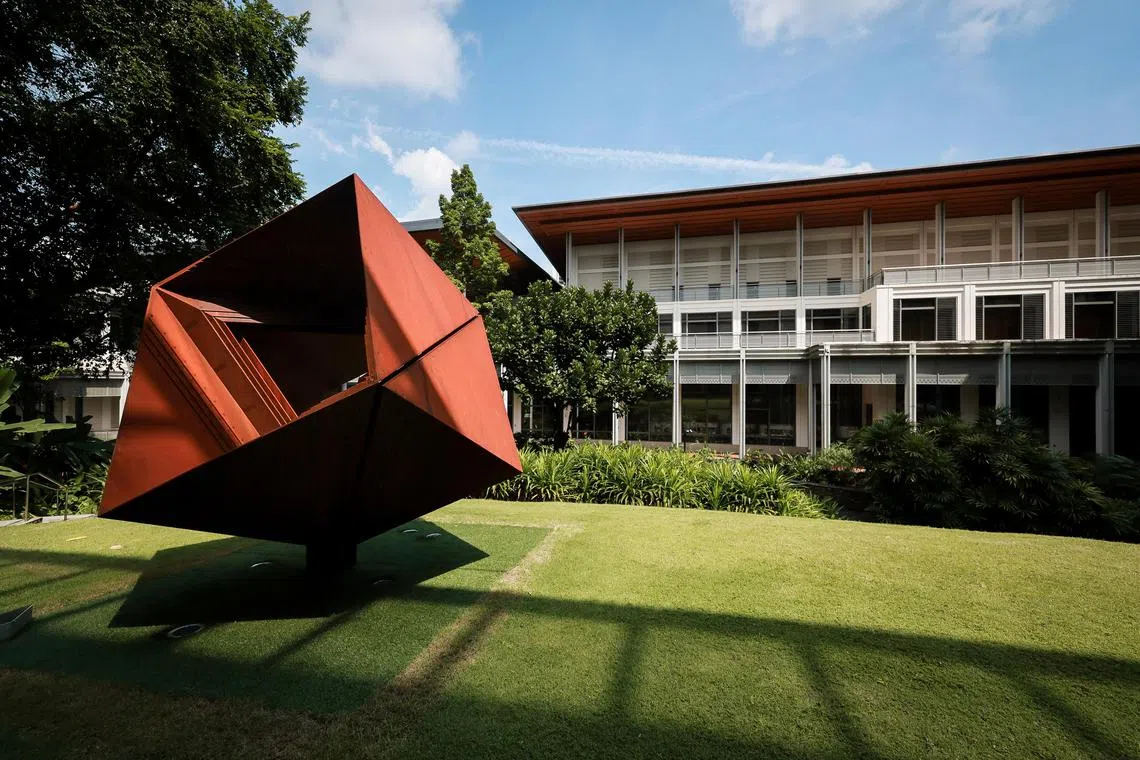NUS College campus redesigned to fit new purpose; some students raise concerns
Sign up now: Get ST's newsletters delivered to your inbox

About 10 per cent of the campus will be redesigned, with some of the most significant changes affecting former arts spaces.
ST PHOTO: GAVIN FOO
Follow topic:
SINGAPORE - Several parts of the former Yale-NUS College (YNC) campus will be redesigned to accommodate the growing needs of NUS College (NUSC)
The renovations come after YNC closed in June
According to NUS campus infrastructure vice-president Koh Yan Leng, the changes were made in consultation with students who expressed a need for more study and student club spaces. He added that NUS aims to keep as much of the former campus as possible.
This sentiment is shared by law students, said NUS Law Club president Isabella Rotschaedl, a third-year student who helped collate student input.
“Of course, there are certain spaces that need to be expanded. It’s purely because YNC was conceptualised as a liberal arts college,” she said, noting that NUS Law has much larger class sizes that would be impractical to house in YNC’s smaller classrooms.
But the redesign has sparked concern among some NUSC students, who say it is an indication of the school’s dwindling focus on the arts.
The changes affect about 10 per cent of the 63,900 sq m campus, and some of the most significant renovations will be to arts spaces such as YNC’s Black Box Theatre and fabrication and carpentry studios.
The conversion of the Black Box Theatre into the Wee Chong Jin Moot Court, in particular, has become a disputed move, despite NUS’ intention for it to be a multipurpose facility.
NUS said it plans to retain the theatre’s state-of-the-art audiovisual equipment and retractable seats, and will ensure all the moot court’s furniture is easily removable so the space can still function as a performance venue.
Mr Koh said the venue can double as a lecture hall, arts or event space despite its new “primary purpose” being a moot court.
Still, its reconstruction means there will no longer be a specialised black box theatre in NUS – which was one of only five such theatres in Singapore. A black box is a theatre characterised by its open concept, neutral backdrop and lack of fixed features, allowing for greater versatility and experimentation when staging performances.

The conversion of the Black Box Theatre into the Wee Chong Jin Moot Court, in particular, has become a disputed move. It is pictured here on July 3, 2025.
ST PHOTO: GAVIN FOO
Third-year NUSC student Larissa Yong, who helped collate student input during the redesign process, said the community had a difficult time accepting the change.
“A lot of our interest groups use the black box,” the 21-year-old said, adding that the theatre was used for weekly practices and performances.
In a statement, the YNC x NUSC Improv troupe said: “Finding spaces for practice has become much more difficult, and the troupe has had to use non-performance venues like common rooms and pantries, coming into conflict with other students.
“While there are facilities elsewhere in the university, these spaces are already crowded and heavily contested by other arts groups.”
Third-year NUSC student Mariah Tamayo is also concerned about whether the limited space can accommodate everyone’s needs. The 21-year-old is part of the college’s dance collective, which had to hold its recent session at the performance hall foyer.
Ms Yong, who is the NUS College Club vice-president of community life, said that while it was good an agreement was made for both parties to share the former theatre, NUSC still lacks space for some of its activities.

(From left) NUS Law undergraduates Noleen Joy Marasigan and Isabella Rotschaedl, and NUS College undergraduate Larissa Yong at the former Yale-NUS College campus.
ST PHOTO: GAVIN FOO
Second-year NUSC student Caius Chew, 22, said the college’s student band has had to move its practices to a common lounge as suitable practice rooms are currently unavailable for booking.
The lounge, however, is not ideal due to inadequate equipment and soundproofing.
“We’d really have liked to inherit the best of both the YNC and University Scholar’s Programme heritage in terms of their music scenes and initiatives, though logistical issues in terms of both space and funding mean that events such as Tape Days don’t really seem plausible in the near future,” he said, referring to YNC’s annual concert.
For one fourth-year NUSC student, who wanted to be known only as Ms Hari, the loss of these spaces signals NUS’ increasing “secondary consideration” for the arts, with Ms Hari noting that Runme Shaw CFA Studios was also shut down in August 2024.
Runme Shaw was a building in NUS that housed the university’s music, dance, theatre and film groups for more than three decades. It was slated for demolition, also as part of NUS’ long-term strategy to optimise campus spaces.
Mr Koh, the NUS campus infrastructure vice-president, said the “main philosophy” behind the redesign is to retain most of the YNC campus’ original character and infrastructure, adding that renovations did not start earlier in order to lessen disruptions to the college’s final cohorts and allow time for conversations on preservation.

Mr Koh said the “main philosophy” behind the redesign is to retain most of the YNC campus’ original character and infrastructure.
ST PHOTO: GAVIN FOO
He said his team also consulted former YNC president Joanne Roberts on what elements of the college to honour and keep.
Professor Roberts, who is now at Bates College in the US, said she was grateful that NUS agreed to preserve and maintain Mater, a legacy sculpture by Singapore-based artist Grace Tan. Other efforts include renaming the performance hall Yale-NUS College Hall, and installing a heritage exhibit chronicling the story and history of the college.
“Jointly, these mark, memorialise and share the Yale-NUS story in important and visible ways. Beyond these tangible tributes, NUS has committed to allowing Yale-NUS alumni continued access to campus spaces for future reunions and events,” she said.
“I hope the campus will continue to be a meaningful place of connection for our community, even as our college has now closed.”
Mr Koh said: “We always ask ourselves, ‘Where are the spaces that we need to preserve, to retain the heritage?’, so that when alumni come back to the campus, they can say, ‘Hey, this is my campus’.”


